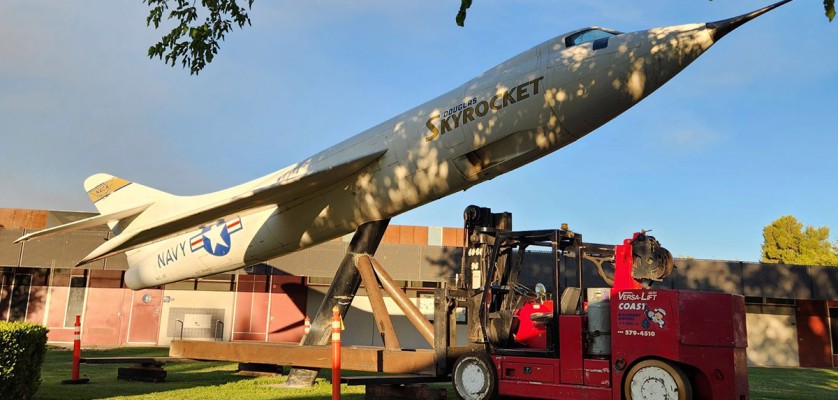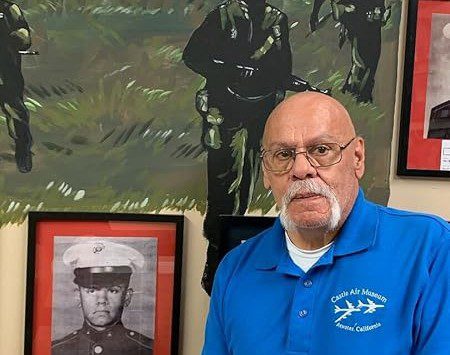By KC Rawley
Aerotech News
Story contribution by Dennis Anderson
The D-558-II Skyrocket that stood on the Antelope Valley College as a proud symbol of the college’s connection with aerospace and Edwards Air Force Base is no longer on display.
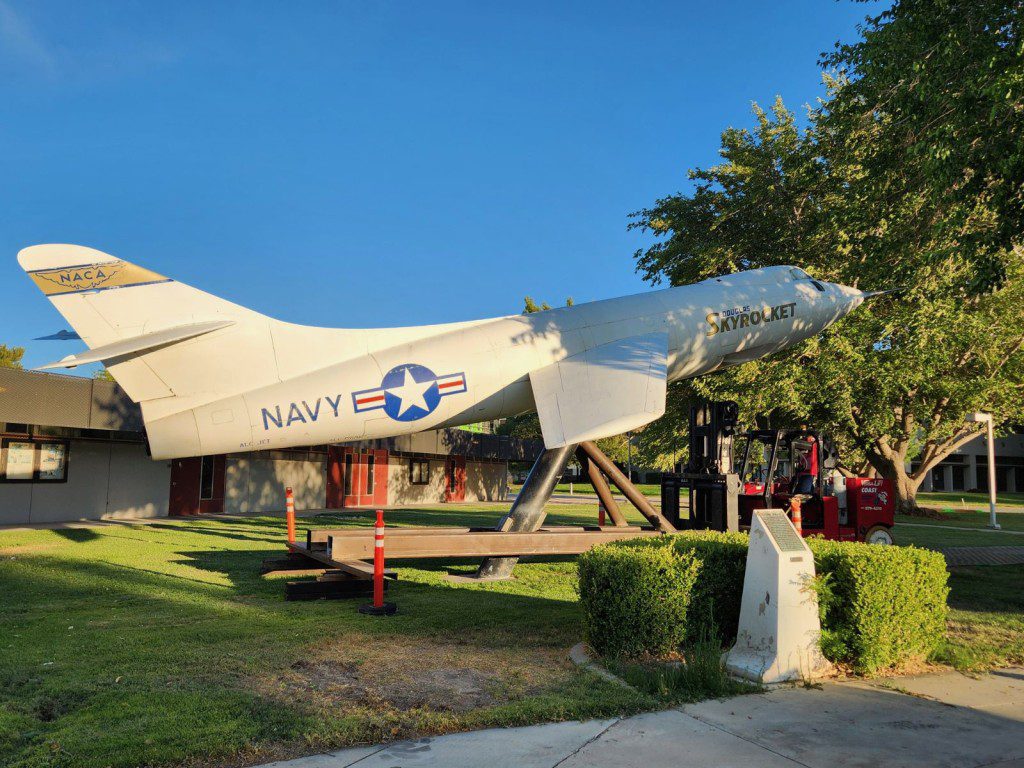
Friday, July 19, after 61 years, the plane was disconnected from its base, and by Sunday, had been moved to an indoor storage location 600 feet away from its original site on AVC’s campus. The plane has been on campus since it was unveiled on May 19, 1963, with a display plaque reading in part: “The men and women of NASA (NACA), the U.S. Navy, the U.S. Air Force Flight Test Center and Douglas Aircraft dedicate this Skyrocket to the youth of Antelope Valley.”
The Skyrocket was moved to facilitate building of the Student Commons, a result of Measure AV construction, expected to break ground in August, and to protect the artifact during that work, according to AVC. The plan is to restore the Skyrocket to its former glory and then put it somewhere on campus, preferably sheltered.
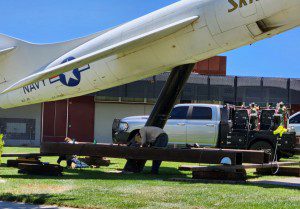
“Step One is movement, and that has been achieved,” said Steve Buffalo, longtime AVC Board of Trustees member and current board clerk. The next step, he said, is for the college and board of trustees to identify a team that has the talent base for refurbishing the aircraft, which has been exposed to the extremes of desert elements for many years.
Ryan Cobb, senior vice president of Coast Machinery Movers, the project’s contractor, said that the Skyrocket is in fairly good shape for enduring heat, wind, and snow for 61 years.
Coast Machinery’s licensed engineers did Ultrasonic Testing on the rocket plane as part of the initial research phase of the project. “UT tests the thickness and condition of the metal, and the integrity of the metal is actually pretty good, all things considered,” said Cobb.
The Skyrocket Serial # 37975 NACA-145 is a rocket and jet-powered research supersonic aircraft built by Douglas Aircraft Company for the United States Navy, but they never took possession of it. The National Advisory Committee for Aeronautics (NACA) was a United States federal agency created in 1915, to “undertake, promote, and institutionalize aeronautical research,” which became NASA in 1958.
AVC’s Skyrocket, NACA 145 Serial # 37975, flew a total of 87 times, 21 of them contractor research flights out of Edwards Air Force Base in November of 1950. The Douglas Aircraft Company test pilots were Eugene F. May and William Bridgeman.
One of only three ever built, the other two D-558-II Skyrockets built still exist, according to Aerotech News files. NACA 143 is currently in storage at Planes of Fame Museum in Ontario, Calif, and the most famous, NACA 144, is in the Smithsonian National Air and Space Museum in Washington, D.C.
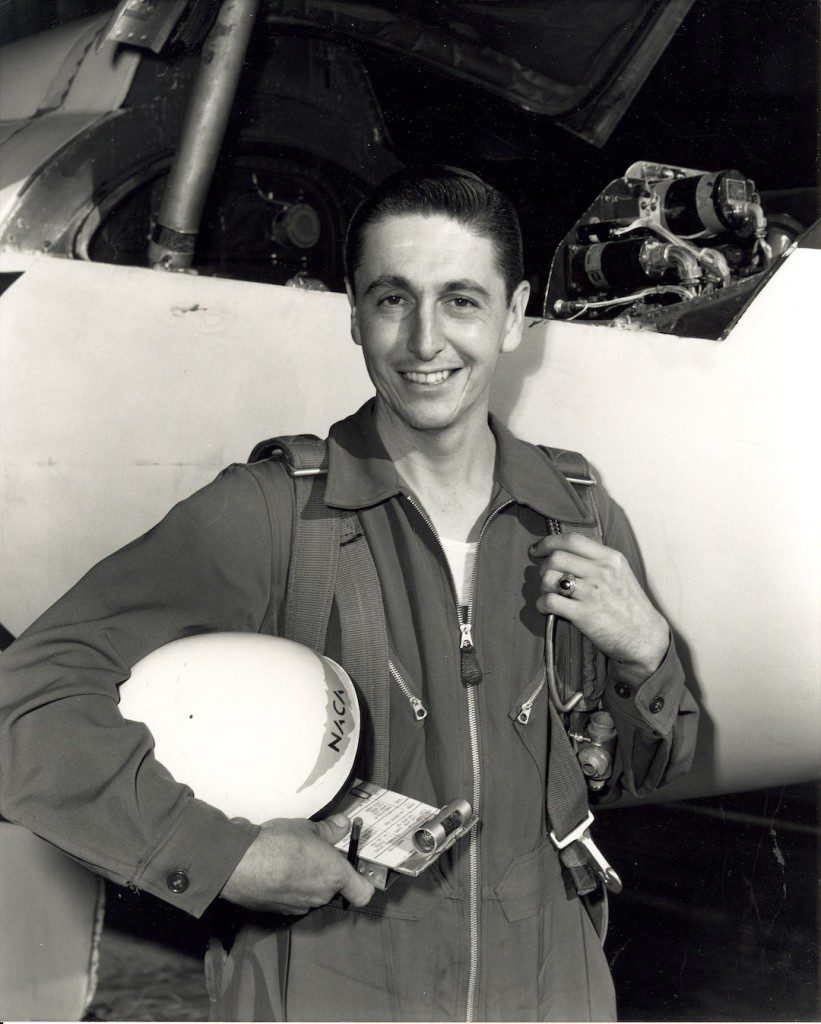
The Smithsonian’s D-558-II Skyrocket NACA 144, piloted by A. Scott Crossfield, made aviation history by becoming the first airplane to fly at 1,291 mph, (2,078 km/h, Mach 2.005) more than twice the speed of sound on November 20, 1953, a fact that Buffalo said would be noted in the new display.
Also accompanying the restored NACA 145 aircraft will be a photo of Crossfield from the college files. Crossfield flew nearly all the experimental aircraft at Edwards AFB, including the X-1, XF-92, X-4, X-5, and the Douglas D-558-I Skystreak.
AV College is paying Coast Machinery Movers $44,000 for the work, which included designing and shop fabricating a lifting fixture, field installation, rigging, cutting existing support pipe, and lifting and traveling to the staging area.
“We understand that our Douglas Skyrocket represents the rich legacy of aircraft testing and development in the Antelope Valley,” said AV College Superintendent/President Jennifer Zellet, PhD. “That’s why we decided to work with one of the best in the industry.”
The Coast Machinery Movers, from South El Monte, previously moved Air Force One in 2003 from San Bernardino to the Ronald Reagan Library in Simi Valley, a six-hour, 100-mile trip that began at 11pm and ended at 5am, according to the company’s website. Dollies at the nose had built-in hydraulics to allow the fuselage to be lowered and raised to go under overpasses.
The company also fabricated and installed the Orbiter Lifting Facility at Plant 42, which placed the Space Shuttle on top of the 747 that flew it back to the Kennedy Space Center from the hangar where it was built in Palmdale.
Cobb is an Antelope Valley native who said the project was “an honor” and had special significance for him. A member of Highland High School’s 1993 first graduating class, Cobb said he and his sister remember the Douglas Skyrocket from their student days at AVC. “I was always running between AVC, Edwards AFB, the Air Force Research Lab, Northrop and Lockheed,” Cobb said.
“On behalf of Coast I’d like to thank AVC for restoring the Skyrocket and keeping this part of AV history alive,” said Cobb.
Many in the Aerospace Valley share Cobb’s affection for the Douglas D-558-II Skyrocket, with generations of AVC students fondly recalling walking by the “plane on a stick.” Some aviation enthusiasts have worried over the years about the condition of the historic plane after being exposed to the elements and questioned the college’s commitment to the care and upkeep of the historic artifact.
Now, after years of speculation, it seems clear that the Skyrocket is here to stay, and AVC plans to make the restored plane a focus point for its expanded aviation and STEM study paths, especially if it is installed near the Career Technical Center.
“Our Airframe Manufacturing Technology students take great pride and inspiration from the Skyrocket, so we’re going to make sure this historical artifact is cared for as it deserves,” said Zellet.
AVC offers an Aerospace, Industrial Arts and Applied Technologies field of study, and in 2016 added a bachelor’s program in Airframe Manufacturing Technology, specifically designed for the needs of local aerospace industry employees. A Bachelor of Science degree in computer science is in the planning stages through the California State University Bakersfield AV Campus.
When refurbishing is achieved, Buffalo said the third step will be deciding on a future display location, which could be indoors in a campus building or outdoors with a structure built around it.
“We will want the plane in a position where people can see it,” said Buffalo.
He added that AVC President Zellet “understands the board is committed to this.”






